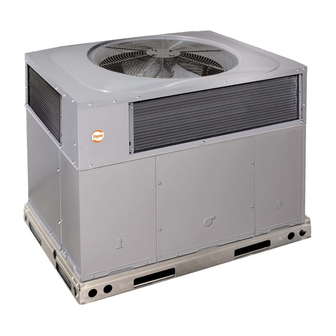Advertisement
Quick Links
Installation Instructions
IMPORTANT:
Effective
January
1, 2015,
all split system
and
packaged
air conditioners
must be installed
pursuant
to applicable
regional
efficiency
standards
issued by the Department
of Energy.
NOTE:
Read
the entire
instruction
manual
before
starting
the
installation.
NOTE:
Installer:
Make
sure the Owner's
Manual
and Service
Instructions
are left with the unit after installation.
TABLE
OF CONTENTS
PAGE
SAFETY
CONSIDERATIONS
.......................
1-2
INTRODUCTION
...................................
2
RECEIVING
AND INSTALLATION
..................
2-9
Check Equipment
..................................
2
Identify
Unit
....................................
2
Inspect
Shipment
.................................
2
Provide
Unit Support
...............................
2
Roof Curb
......................................
2
Slab Mount
.....................................
2
Provide
Clearances
.................................
6
Rig and Place Unit
.................................
6
Inspection
......................................
6
Rigging/Lifting
of Unit
............................
6
Select and Install Ductwork
...........................
6
Converting
Horizontal
Discharge
Units to Downflow
(Vertical)
Discharge
Units
..........................
7
Provide
for Condensate
Disposal
......................
8
Install Electrical
Connections
.........................
8
High-Voltage
Connections
.........................
9
Special
Procedures
for 208-V
Operation
...............
9
Control
Voltage Connections
........................
9
Standard
Connections
.............................
9
Transformer
Protection
............................
9
Accessory
Electric Heaters
Installation
................
9
PRE-START-UP
...................................
17
START-UP
.....................................
17-21
Checking
Cooling
& Heating
Control
Operation
........
17
Check for Refrigerant
Leaks
.........................
17
Start-Up
Adjustments
.............................
17
PH3G--A
Sequence
of Operation
...................
18
Checking
& Adjusting
Refrigerant
Charge
............
18
Indoor Airflow
& Airflow
Adjustments
..............
18
Continuous
Fan Operation
........................
19
Defrost
Control
...................................
21
Quiet Shift
.....................................
21
Defrost
.......................................
21
MAINTENANCE
................................
21-27
Air Filter
........................................
21
Indoor
Blower
and Motor
...........................
21
Outdoor
Coil, Indoor
Coil, & Condensate
Drain Pan
......
22
Outdoor
Fan
.....................................
22
Electrical
Controls
and Wiring
.......................
30
Refrigerant
Circuit
.................................
30
Indoor Airflow
...................................
31
Metering
Devices-
TXV & Piston
....................
31
Aogl 8S
Fig. 1 - Unit PH3G--A
Pressure
Switches
.................................
31
Loss of Charge
Switch
.............................
31
High Pressure
Switch
..............................
31
Copeland
Scroll compressor
(R-410A
Refrigerant)
.......
31
Refrigerant
System
................................
31
Refrigerant
....................................
31
Compressor
Oil .................................
31
Servicing
Systems
on Roofs with Synthetic
Materials
....
31
Liquid Line Filter Drier ...........................
32
R-410A
Refrigerant
Charging
......................
32
System
Information
................................
32
Physical
Data
....................................
32
Loss of Charge Switch
............................
32
Check Defrost Thermostat
.........................
32
TROUBLESHOOTING
..............................
32
START-UP
CHECKLIST
............................
32
SAFETY
CONSIDERATIONS
Installation
and servicing
of this equipment
can be hazardous
due
to
mechanical
and
electrical
components.
Only
trained
and
qualified
personnel
should
install, repair, or service this equipment.
Untrained
personnel
can perform
basic maintenance
functions
such
as cleaning
and replacing
air filters.
All other operations
must be
performed
by trained
service
personnel.
When
working
on this
equipment,
observe
precautions
in the literature,
on tags,
and on
labels
attached
to
or shipped
with
the
unit
and
other
safety
precautions
that may apply.
Follow
all safety codes.
Wear safety
glasses,
protective
clothing,
and work
gloves.
Use quenching
cloth
for brazing
operations.
Have
a fire
extinguisher
available.
Read
these
instructions
thoroughly
and
follow
all warnings
or cautions
included
in
literature
and
attached
to the unit. Consult
local building
codes, the
Advertisement










